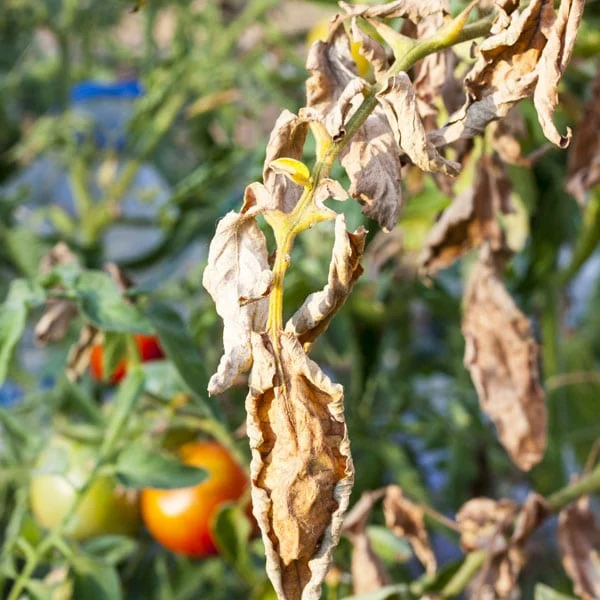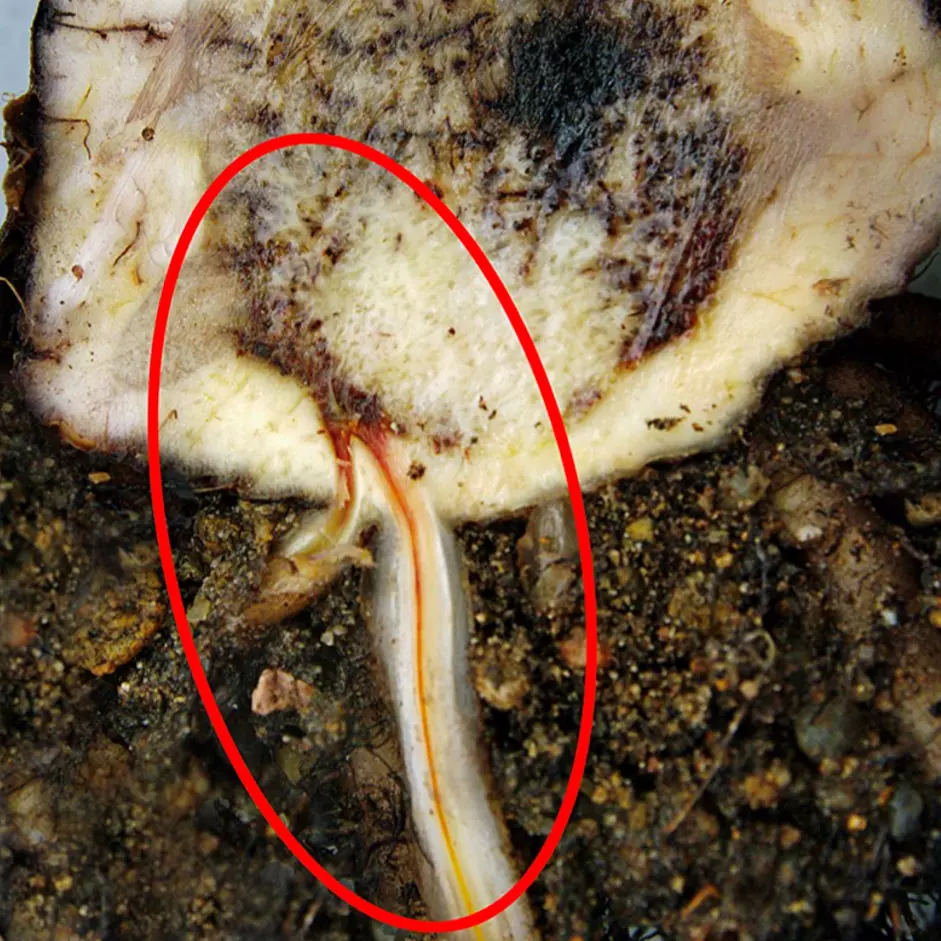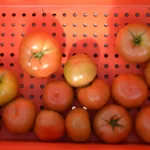
Written by: Becky Anderson
Published by: David Santos
What is Fusarium oxysporum?
Fusarium oxysporum is a fungus which can cause root rot, crown rot and, most commonly, wilting in a wide variety of crops such as basil, lettuce, cannabis and tomatoes (Figure 1). Wilting caused by F. oxysporum is known as Fusarium wilt and is a common culprit in field agriculture but is also highly damaging in hydroponic systems. Diseases caused by Fusarium infection are economically devastating and lead to substantial yield loss [1], especially in hydroponics. Not only is F. oxysporum a problem with the crops mentioned above, but it is also found in many other foods such as cereals, peas, beans, nuts, bananas, onions, potatoes, citrus fruits, apples [2] and ornamental plants (Figure 2).

On top of its ability to infect diverse plant species, the toxins Fusarium produces are dangerous to humans and can cause a serious illness called fusariosis [3]. Symptoms of fusariosis depend on the area of infection. Still, they include fever, pneumonia, inflamed cornea, thickening and discoloration of keratin (e.g. nails), inflammation of the peritoneum, and redness or swelling of the skin [4].
![Figure 2. Image and caption [5] “Symptoms caused by Fusarium oxysporum on ornamental plants: Cyclamen sp. (a), Mandevilla sp. (b), Tulipa sp. (c), Eustoma sp. (d), Dianthus sp. (e), Gladiolus sp. (f)”](https://www.healthyhydroponics.ca/wp-content/uploads/2022/09/Fusarium-ornamental-plant.webp)
Infection and Symptoms:
Fusarium oxysporum grow internally through the plant’s roots, vascular system (xylem) and sap stream [6]. You can see internal browning where the fungi have spread, such as in the vascular tissue of a banana plant (Figure 3) [7;8]. Although bananas are not hydroponically grown, this figure gives you an idea of the internal damage caused by F. oxysporum infection.
Disease caused by Fusarium can present itself as wilting and death at a young age (seedling stage), stunted growth of the plant, yellowing/browning of the leaves, and ultimately wilting of leaves, stems and defoliation (Figure 1) [6]. This fungus shows advanced symptoms internally before the disease is visible externally. For example, the incubation period of Fusarium wilt in bananas ranges between 2-6 months before symptoms appear [8], making it difficult to control once the infection has begun.
Incubation period – the time it takes between initial infection from the pathogen and the development of symptoms
![Figure 3. On the left is an image of browning in the vascular tissue of banana roots. On the right is browning (vascular discoloration) in the xylem tissue in the banana [8].](https://www.healthyhydroponics.ca/wp-content/uploads/2022/09/fusarium-banana-1024x658.webp)
We provide great overviews of many agricultural microorganisms. Subscribe to stay updated!
Fusarium oxysporum is a species complex because of its phylogenetic diversity and pathogenic strains [5], causing a range of diseases in various plants. However, there are specific groups of “subspecies” (formae speciales) of F. oxysporum, which are responsible for different diseases (Table 1). Among these “subspecies,” different strains, called races, are classified based on their varying levels of virulence. To date there are over 150 formae speciales and races of F. oxysporum! You can now imagine why Fusarium infection can be so detrimental and complicated to diagnose.
Phylogenetic – the evolutionary development or diversification of a species
Pathogenic – the ability of a microorganism (e.g. bacteria, virus or fungi) to cause disease
Subspecies – a taxonomic category that is one level below species
Forma(e) speciales – a non-official taxonomic ranking used for fungi, plants or algae
Strains – a term used to distinguish variants of the same species, from a different lineage
Race – a population (e.g. fungi) that is isolated from a specific area (away from other fungi of the same species) but is distinguishable from fungi of the same species (e.g. via their genes or appearance)
Virulence – similar to pathogenic, but is the degree of disease in which a pathogenic microorganism can cause
Table 1. Diseases caused by Fusarium oxysporum subspecies (forma specialis) and their associated plant targets and families.
|
Subspecies/forma specialis |
Host Plant |
Plant Family |
Disease |
|
apii |
Celery |
Apiaceae |
Fusarium yellows |
|
batatas |
Sweet potato |
Convolvulacea |
Sweet potato wilt |
|
cepae |
Onion/green onion |
Fusarium basal rot |
|
|
conglutinans |
Cabbage |
Brassicaceae |
Fusarium yellows / Fusarium wilt |
|
cubense |
Banana |
Musaceae |
Panama disease (Fusarium wilt of bananas) |
|
cucumerinum |
Cucumber |
Cucurbitaceae |
Fusarium wilt |
|
lycopersici |
Tomato |
Solanaceae |
Fusarium wilt |
|
melongena |
Eggplant |
Solanaceae |
Fusarium wilt |
|
melonis |
Melon |
Cucurbitaceae |
Fusarium wilt |
|
niveum |
Watermelon/melon |
Cucurbitaceae |
Fusarium wilt |
|
pisi |
Pea |
Fabaceae |
Pea wilt |
|
raphani |
Daikon radish |
Brassicaceae |
Wilt of radish/ Fusarium wilt |
|
rapae |
Field mustard |
Brassicaceae |
Fusarium wilt |
|
spinaceae |
Spinach |
Amaranthaceae |
Fusarium wilt |
|
tulipae |
Tulip |
Liliaceae |
Fusarium basal rot |
Information in this table is adapted from [9;8]
Although F. oxysporum is known as being a soilborne pathogen, it can be transmitted on the surface of objects, such as contaminated tools or clothing or by direct contact with infected plants. The pathogen is also known to live and be carried on the surface of seeds, potentially making its way into fields and indoor agricultural environments.
Growth Conditions:
Fusarium oxysporum is a soilborne fungal pathogen which naturally inhabits the soil and typically infects plants through their roots. Fusarium oxysporum can grow in temperatures from 5 – 37°C and pH of 2.2 – 9 [2]. These qualities make it a culprit of foodborne illness if the food is somehow contaminated along the way, as it can grow and proliferate at cooler temperatures, such as in a refrigerator.
Treatment and methods of control:
Resistant cultivars can be used to reduce the likelihood of infection and control the spread of disease. Fungicides are another commonly used control method. However, due to the overuse of fungicides, resistant strains have increased and become a problem. Such as the case with sweet potato wilt in Japan [9]. Botanicals are a natural method of treatment [5] and are an environmentally friendly alternative to traditional fungicides because they are biodegradable and do not persist in water or soil [5]. Additionally, they can be administered through microcapsules or a coating on the seed [5], making them an easy and safe method for disease control.
Botanicals – extracts or essential oils derived from plants
Biocontrol methods are a popular method of control due to their environmental friendliness, safety and use on organic farms (Check out our blog post on Biocontrol Methods). The fungi Trichoderma atroviride, Talaromyces flavus and non-pathogenic Fusarium oxysporum have been used to control pathogenic Fusarium infections in crops [9]. The latter, non-pathogenic Fusarium oxysporum, has successfully been used in hydroponic systems to control infection of various crops, including tomato, basil, watermelon, cucumber and pepper [10;11].
Fusarium can proliferate and infect your plants for months before an indication of disease. Early detection through surveillance methods is imperative for proper treatment and controlling the infection before it spreads and destroys crops. We test for multiple species of Fusarium, including F. oxysporum. Send us an email at 📧 [email protected]. We are happy to help and develop a sampling schedule that best suits your needs!
Disclaimer:
The information we present in Pathogen Profile is based on collating published peer-reviewed scientific literature and sources we think are reliable. This is by no means an exhaustive review of pathogens. Pathogen Profile gives a small glimpse of what is known about pathogens and we encourage growers to do more research on their own based on the pathogens in relation to their own crops and hydroponic systems. We are not plant pathologists thus the information presented in Pathogen Profile should not be used as professional advice to treat pathogens or operate your hydroponic system.
References:
- K.S. Juber, H.H. Al-juboory, S.B.A. (2014). Juboory. Fusarium wilt disease of strawberry caused by Fusarium oxysporum f. sp. fragariae in Iraq and its control. J. Exp. Biol. Agric. Sci., 2 (2014), pp. 419-427
- Thrane, U. (1999). Fusarium. Encyclopedia of Food Microbiology. Elsevier, pp. 901-906.
- Batista BG, Chaves MA, Reginatto P, Saraiva OJ, Fuentefria AM. (2020). Human fusariosis: An emerging infection that is difficult to treat. Rev Soc Bras Med Trop.
- M.C. Dignani, E. Anaissie. (2004). Human fusariosis. Clin. Microbiol. Infect., 10, pp. 67-75.
- Lecomte, C., Alabouvette, C., Edel-Hermann, V., Robert, F., Steinberg, C. (2016). Biological control of ornamental plant diseases caused by Fusarium oxysporum: a review. Biol. Control 101.
- Borrego-Benjumea, A, Basallote-Ureba, M.J., Abbasi, P.A., Lazarovits, G., Melero-Vara, J.M. (2014). Effects of incubation temperature on the organic amendment-mediated control of Fusarium wilt of tomato.
- Song, W., Zhou, L., Yang, C., Cao, X., Zhang, L., & Liu, X. (2004). Tomato fusarium wilt and its chemical control strategies in a hydroponic system. Crop Protection, 23(3), 243–247.
- Pegg KG, Coates LM, O’Neill WT and Turner DW (2019) The Epidemiology of Fusarium Wilt of Banana. Front. Plant Sci. 10:1395.
- Arie T. Fusarium diseases of cultivated plants, control, diagnosis, and molecular and genetic studies. J Pestic Sci. 2019 Jul 25;44(4):275-281.
- Fravel, D. R., and Larkin, R. P. (2002). Reduction of fusarium wilt of hydroponically grown basil by Fusarium oxysporum strain CS-20. Crop Prot. 21 (7), 539–543.
- de Lamo FJ and Takken FLW (2020) Biocontrol by Fusarium oxysporum Using EndophyteMediated Resistance. Front. Plant Sci. 11:37.
Looking for more useful info? Go back to the Blog Page or check out the Resources Page.





